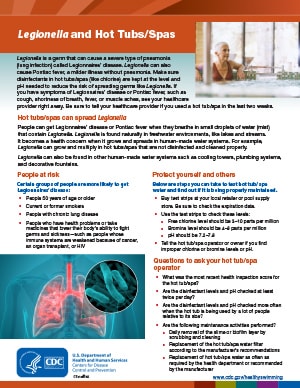Legionella Infections
Swimmers are at risk for respiratory infections if they breathe in small droplets of water (mist) from a pool or hot tub that contains harmful germs. A respiratory disease caused by the germ Legionella is one of the most common waterborne diseases in the United States.
Legionella and Hot Tubs/Spas
Legionella is a germ that can cause a severe type of pneumonia (lung infection) called Legionnaires’ disease. Legionella can also cause Pontiac fever, a milder illness without pneumonia. Make sure disinfectants in hot tubs/spas (like chlorine) are kept at the level and pH needed to reduce the risk of spreading germs like Legionella. If you have symptoms of Legionnaires’ disease or Pontiac fever, such as cough, shortness of breath, fever, or muscle aches, see your healthcare provider right away. Be sure to tell your healthcare provider if you used a hot tub/spa in the last two weeks.
Hot tubs/spas can spread Legionella
People can get Legionnaires’ disease or Pontiac fever when they breathe in small droplets of water (mist) that contain Legionella. Legionella is found naturally in freshwater environments, like lakes and streams. It becomes a health concern when it grows and spreads in human-made water systems. For example, Legionella can grow and multiply in hot tubs/spas that are not disinfected and cleaned properly.
Legionella can also be found in other human-made water systems such as cooling towers, plumbing systems, and decorative fountains.

People at risk
Certain groups of people are more likely to get Legionnaires’ disease:
- People 50 years of age or older
- Current or former smokers
- People with chronic lung disease
- People who have health problems or take medicines that lower their body’s ability to fight germs and sickness—such as people whose immune systems are weakened because of cancer, an organ transplant, or HIV
Protect yourself and others
Below are steps you can take to test hot tub/ spa water and find out if it is being properly maintained.
- Buy test strips at your local retailer or pool supply store. Be sure to check the expiration date.
- Use the test strips to check these levels:
- Free chlorine level should be 3–10 parts per million
- Bromine level should be 4–8 parts per million
- pH should be 7.2–7.8
- Tell the hot tub/spa operator or owner if you find improper chlorine or bromine levels or pH.
- What was the most recent health inspection score for the hot tub/spa?
- Are the disinfectant levels and pH checked at least twice per day?
- Are the disinfectant levels and pH checked more often when the hot tub is being used by a lot of people relative to its size?
- Are the following maintenance activities performed?
- Daily removal of the slime or biofilm layer by scrubbing and cleaning
- Replacement of the hot tub/spa water filter according to the manufacturer’s recommendations
- Replacement of hot tub/spa water as often as required by the health department or recommended by the manufacturer
